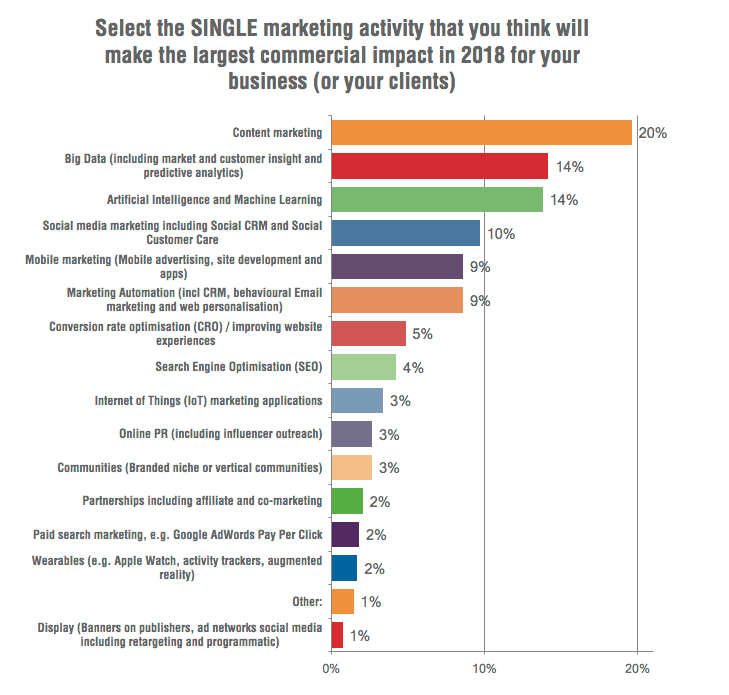When building a brand and selling a product, marketers will find that there are multiple strategies available. When it comes to lead generation, there are two methods available at their disposal: inbound marketing and outbound marketing.
In years past, outbound marketing dominated the sector. It wasn’t until the past few years that SaaS companies have begun making a shift to SaaS inbound marketing strategies, coming up with innovative new ways to not only improve the number of leads but the quality as well.
At the beginning of 2018, a survey asked marketers, “Which activity will make the largest commercial impact in 2018?” There were more than 15 different tactics to choose from. Approximately 20 percent of those who responded indicated that content marketing would make the most substantial commercial impact on their business. For comparison, only 4% of respondents indicated Search Engine Optimization (SEO) as the activity that would have the largest impact.

(Source: SmartInsights.com)
Furthermore, if you are not already utilizing content marketing, you may be falling behind. In the Content Marketing Institute’s 2018 B2B Content Marketing Report, statistics revealed that more than 90 percent of B2B companies had already begun utilizing the strategy. Additionally, of the roughly ten percent of companies who said they did not currently use the approach, more than half said that they planned to begin to do so within the next year. This means that by the end of 2018, a mere five percent of businesses will not be utilizing some form of content marketing.
One of the reasons content marketing has become such a popular option is because of its proven results. When implementing a content marketing strategy, companies see their conversion rates increase by nearly 600%, from an average 0.5% to nearly 3%. This is significant!
Content marketing can be broken down into three primary components. Maximizing your capabilities in all three sectors will increase the effectiveness of your marketing campaign significantly. The three parts are:
- Generating awareness
- Creating demand
- Acquiring new customers
Defining Content Marketing
Before breaking down the various components of content marketing, it’s imperative to understand what content marketing is. Content marketing involves coming up with original content that helps solve your target customers challenges and problems and then publishing it on your website, amplifying it through marketing channels, and syndicating it on third party websites. Conceptually, this is a broad topic, but is likely the most effective marketing strategy for SaaS companies today.
SaaS companies can create various types of organic content, including articles, infographics, podcasts, webinars, white papers or e-books, and videos, then share and promote that content to target audiences. What tends to set content marketing apart from other forms of marketing, is the fact that it is not overly promotional. Content marketing relies upon building a relationship with consumers and gaining their trust.
Content marketing generates over three times as many leads as outbound marketing and costs 62% less.
The fact that companies are taking a softer, non-salesy approach with content marketing is an integral component to building trust with potential customers. While some content marketing materials can and should contain a “Call to Action” that prompts your audience to take an action, this will not be the case for every piece of content. Instead of trying to sell the audience on a product, content marketing strategies rely on producing content that serves the audience’s interests. We’ll touch more on Calls to Action later.
An excellent example of this is the Creative Trends Infographic that Shutterstock publishes on an annual basis. This is something that creates a lot of buzz for the company, as those in the graphic design industry look forward to its release every year. The report not only analyzes various user data points but publishes the data in a unique graphic.
The notoriety that this report has gained has paid tremendous dividends for Shutterstock. For instance, data shows that the 2017 report resulted in Shutterstock being mentioned in more than 100 organic articles, equaling six billion unique site visits. Users shared the story on social media roughly 5,300 times for a total of more than 11,000 social media engagements.











